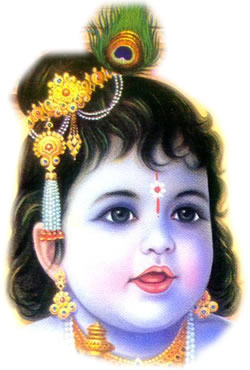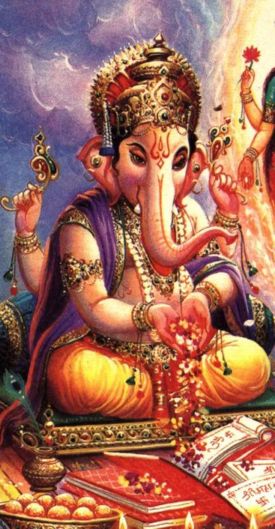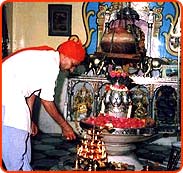





In Hinduism, Ganesha (when used to distinguish lordly status) (or "lord of the hosts," also spelled as Ganesa and Ganesh, often also referred to as Ganapati) is one of the most well-known and venerated representations of God. He is the first son of Shiva and Parvati, and the 'consort' of Buddhi (also called Riddhi) and Siddhi. 'Ga' symbolizes Buddhi (intellect) and 'Na' symbolizes Vidnyana (wisdom). Ganesha is thus considered the master of intellect and wisdom. He is depicted as a big-bellied, yellow or red god with four arms and the head of a one-tusked elephant, riding on, or attended to by, a mouse. He is frequently represented sitting down, with one leg raised in the air and bent over the other. Typically, his name is prefixed with the Hindu title of respect, 'Shree' or Sri.Ganapati is popularly worshipped in different avataras such as Krishna, Sage Parashurama, Naga (the snake god). He is also depicted as a warrior king and at times in a playful mood with dandiya sticks, the symbol of the navaratri festival.The popularity of Ganesha is widely diffused, even outside of India. Some of his devotees identify Ganesha as the Supreme deity and are called the Ganapatya.






form with which Hinduism represents god, in the sense of the personal appearance of Brahman (also referred to as Ishvara, the Lord), the figure of Ganesha too is an archetype loaded with multiple meanings and symbolism which expresses a state of perfection as well as the means of obtaining it. Ganesha, in fact, is the symbol of he who has discovered the Divinity within himself.Ganesha is the first sound, OM, in which all hymns were born. When Shakti (Energy / Matter) and Shiva (Being / Consciousness) meet, both Sound (Ganesha)and Light ( Skanda) were born. He represents the perfect equilibrium between force and kindness and between power and beauty. He also symbolizes the discriminative capacities which provide the ability to perceive distinctions between truth and illusion, the real and the unreal. A description of all of the characteristics and attributes of Ganesha can be found in the Ganapati Upanishad (an Upanishad dedicated to Ganesha) of the rishi Atharva, in which Ganesha is identified with Brahman and Atman. This Vedic Hymn also contains one of the most famous mantras associated with this divinity: Om Gam Ganapataye Namah (literally, I surrender myself to You, Lord of the hosts). According to the strict rules of Hindu iconography, Ganesha figures with only two hands are taboo. Hence, Ganesha figures are most commonly seen with four hands which signify their divinity. Some figures may be seen with six, some with eight, some with ten, some with twelve and some with fourteen hands, each hand carrying a symbol which differs from the symbols in other hands, there being about fifty-seven symbols in all, according to some scholars. The image of Ganesha is a composite one. Four animals, man, elephant, the serpent and the mouse have contributed to the makeup of his figure. All of them individually and collectively have deep symbolic significance.
In general terms, Ganesha is a much beloved and frequently invoked divinity, since he is the Lord of Good Fortune who provides prosperity and fortune and also the Destroyer of Obstacles of a material or spiritual order. It is for this reason that his grace is invoked before the undertaking of any task (e.g. traveling, taking an examination, conducting a business affair, a job interview, performing a ceremony,) with such incantations as Aum Shri Ganeshaya Namah (hail the name of Ganesha), or similar. It is also for this reason that, traditionally, all sessions of bhajan (devotional chanting) begin with an invocation of Ganesha, Lord of the "good beginnings" of chants. Throughout India and the Hindu culture, Lord Ganesha is the first icon placed into any new home or abode. Moreover, Ganesha is associated with the first chakra (wheel), which represents the instinct of conservation and survival, of procreation and material well-being.

Ganesha is also described as Omkara or Aumkara, that is having the form of Om.[4] The shape of his body is a copy of the outline of the Devanagari letter which indicates the celebrated Bija Mantra. For this reason, Ganesha is considered the bodily incarnation of the entire Cosmos, He who is at the base of all of the phenomenal world (Vishvadhara, Jagadoddhara). Moreover, in the Tamil language, the sacred syllable is indicated precisely by a character which recalls the shape of the elephant's head of Ganesha
According to one interpretation, Ganesha's divine vehicle, the rat or mooshikam represents wisdom, talent and intelligence. It symbolizes minute investigation of a cryptic subject. A rat leads a secret life below the ground. Thus it is also a symbol of ignorance that is dominant in darkness and fears light and knowledge. As the vehicle of Lord Ganesha, a rat teaches us to remain always on alert and illuminate our inner-self with the light of knowledge. Both Ganesha and the Mooshak love modaka, a sweet dish which is traditionally offered to them both during worship ceremonies. The Mooshak is usually depicted as very small in relation to Ganesha, in contrast to the depictions of vehicles of other deities. However, it was once traditional in Maharashtrian art to depict Mooshak as a very large rat, and for Ganesha to be mounted on him like a horse. Yet another interpretation says that the rat (Mushika or Akhu) represents the ego, the mind with all of its desires, and the pride of the individual. Ganesha, riding atop the rat, becomes the master (and not the slave) of these tendencies, indicating the power that the intellect and the discriminative faculties have over the mind. Moreover, the rat (extremely voracious by nature) is often depicted next to a plate of sweets with his eyes turned toward Ganesha while he tightly holds on to a morsel of food between his paws, as if expecting an order from Ganesha. This represents the mind which has been completely subordinated to the superior faculty of the intellect, the mind under strict supervision, which fixes Ganesha and does not approach the food unless it has permission. Lastly it is a very evocative presentation of how humble and modest one should be. Ganesha in spite of his huge physical, mental and intellectual prowess conducts and carries himself so lightly that he can very well be carried by a very very small (compared to the size of Ganesha) and insignificant being-the rat

The highly articulated mythology of Hinduism presents many stories which explain how Ganesha obtained his elephant head; often the origin of this particular attribute is to be found in the same anecdotes which tell about his birth. And many of these same stories reveal the origins of the enormous popularity of his cult
Decapitated and reanimated by Shiva

The most well-known story is probably the one taken from the Shiva Purana. Once, while his mother Parvati wanted to take a bath, there were no attendants around to guard her and stop anyone from accidentally entering the house. Hence she created an image of a boy out of turmeric paste which she prepared to cleanse her body (turmeric was used for its antiseptic and cooling properties), and infused life into it, and thus Ganesha was born. Parvati ordered Ganesha not to allow anyone to enter the house, and Ganesha obediently followed his mother's orders. After a while Shiva returned from outside, and as he tried to enter the house, Ganesha stopped him. Shiva was infuriated at this strange little boy who dared to challenge him. He told Ganesha that he was Parvati's husband, and demanded that Ganesha let him go in. But Ganesha would not hear any person's word other than his dear mother's. Shiva lost his patience and had a fierce battle with Ganesha. At last he severed Ganesha's head with his Trishula (trident). When Parvati came out and saw her son's lifeless body, she was very angry and sad. She demanded that Shiva restore Ganesha's life at once. Unfortunately, Shiva's Trishula was so powerful that it had hurled Ganesha's head very far off. All attempts to find the head were in vain. As a last resort, Shiva approached Brahma who suggested that he replace Ganesha's head with the first living being that came his way which lay with its head facing north. Shiva then sent his celestial armies (Gana) to find and take the head of whatever creature they happened to find asleep with its head facing north. They found a dying elephant which slept in this manner, and after its death took its head, attaching the elephant's head to Ganesha's body and bringing him back to life. From then on, he was called Ganapathi, or head of the celestial armies, and was to be worshipped by everyone before beginning any activity. Festivals and worship of Ganesha In India, there is an important festival honouring Lord Ganesha. While it is most popular in the state of Maharashtra, it is performed all over India. It is celebrated for ten days starting from Ganesh Chaturthi.[7] This festival is celebrated and it culminates on the day of Ananta Chaturdashi when the murti of Lord Ganesha is immersed into the most convenient body of water. In Mumbai (earlier known as Bombay), the murti is immersed in the Arabian Sea and in Pune the Mula-Mutha river. In various North and East Indian cities, like Kolkata, they are immersed in the holy Ganga river. One who really wants to taste the festival needs to come down to the city of Mumbai; particularly at Lalbaug where the divine idol of Lalbaugcha raja (The Lord Of Lalbaug, as Ganesha is fondly called) is set. The Ganesha festival starts on Ganesh Chaturthi (fourth day of Hindu calendar month Bhadrapada) and ends on Anant Chaturdashi (fourteenth day of Bhadrapada). While the Ganapati festival is celebrated by Hindus throughout the Country with great devotional fervour, in Mumbai, the Country’s richest and most populated city, the festival assumes awesome proportions. On the last day of the festival, millions of people of all ages descend onto the streets leading up to the sea, dancing and singing, to the rhythmic accompaniment of drums and cymbals [8]. The town of Pen in Raigad district of Maharashtra is famous for producing the most beautiful Ganesh murtis(idols). The skilled artists from this town make Ganesh murtis all around the year to meet the demand of the murtis in Ganesh festival.

